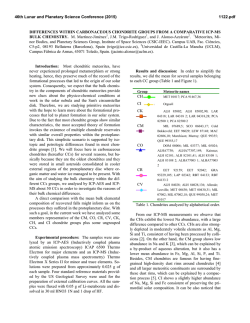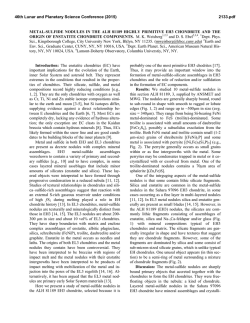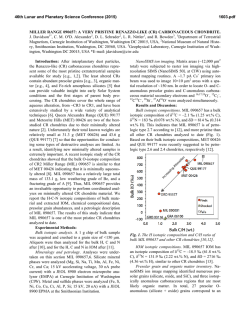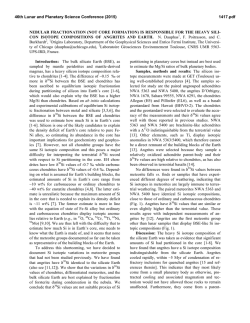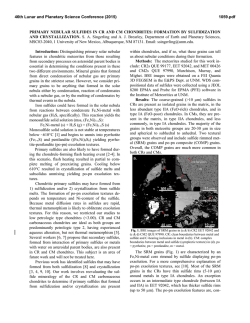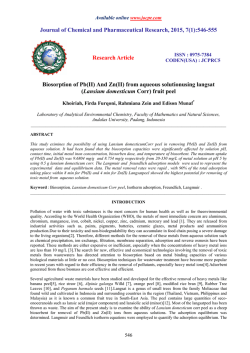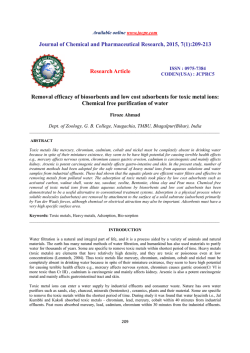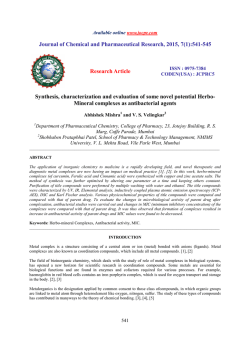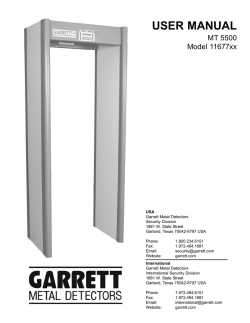
182
46th Lunar and Planetary Science Conference (2015) 2172.pdf 182 Hf-182W ISOTOPIC SYSTEMATICS OF H CHONDRITES: THERMAL HISTORY OF THE H CHONDRITE PARENT BODY G. J. Archer1, M. Touboul1, R. J. Walker1, and J. T. Wasson2. 1Department of Geology, University of Maryland, College Park, MD 20742 ([email protected]). 2Dept. of Earth, Planetary & Space Sciences, University of California, Los Angeles, CA 90095. Introduction: The short-lived 182Hf-182W isotopic system (t1⁄2 = 8.9±0.09 Ma) is useful for constraining the timing of early Solar System metal-silicate equilibration, given the strongly lithophile nature of Hf and the moderately siderophile nature of W. Consequently, this isotopic system has commonly been used to constrain the timing of planetary accretion and core segregation [e.g., 1]. On a finer scale, the system can also potentially be used as a thermochronometer to determine relative closure ages for the cooling of metalsilicate systems following metamorphic heating [2]. Thus, the thermal evolution of some metal-bearing parent bodies can be constrained using this system. Chondritic meteorites commonly contain evidence for complex processing on their respective parent bodies, including aqueous alteration and thermal metamorphism. For example, the H chondrites experienced a large range of thermal-metamorphic conditions [3]. Comparative isotopic closure ages of H chondrites of different metamorphic grade can, therefore, be used to constrain the thermal history of the parent body. The Hf-W isotopic system is ideal for this as H chondrites contain abundant, W-rich metal grains (~660 to ~926 ppb [2]), which are appropriate for high-precision W isotopic measurements. Metal grains in H chondrites typically occur as irregular grains smaller than 0.1 mm2, large metal nodules [4], veins [5], and small metal grains within chondrules [6]. Prior studies have reported that large metal nodules of some H chondrites have different siderophile element abundances than fine-grained metal grains [7,8]. Large metal nodules and veins have extreme depletions (up to a factor of 240 [7]) of the refractory siderophile elements. Prior studies have investigated the Hf-W isotopic systematics of H chondrites to constrain the thermal history of the H chondrite parent body. For example, [2] reported that 182W/184W may increase slightly with metamorphic grade, which suggests an inverse correlation between petrologic type and cooling rates. They argued that this correlation is most consistent with an onion-shell model for the structure of the H chondrite parent body. For that study, however, the 182W/184W of individual H chondrite metal fractions were generally indistinguishable within analytical uncertainties (typically greater than 15 µ182W 2SD uncertainties for individual metal measurements; where µ182W is defined as the isotopic deviation in parts per million of 182W/184W from a terrestrial standard). They therefore relied on linear regressions of metals and silicates to constrain high-precision initial 182W/184W for the bulk rock. However, this approach was unable resolve variations in 182W/184W among different sized metal fractions, which do not necessarily record the same thermal history. Here we report high-precision (±4.5 ppm 2SD external precision) W isotopic compositions for two metal size fractions from the H4 chondrite Faucett. One objective of this study is to assess whether or not different metal size fractions record different closure ages in these rocks, as might occur if the finer metal grains continued to incorporate 182W from the Hf-rich, silicate portion of the rock to lower temperatures compared with coarser fractions. The ultimate goal of this work will be to compare results with comparable data for H chondrites of higher and lower metamorphic grade. Methods: Fifteen grams of the H4 chondrite Faucett were gently crushed using a mortar and pestle. The crushed sample was then sieved into two size fractions, >150 µm and <150 µm. Metal from each size fraction was then separated using a hand magnet. Metal was then purified by repeatedly crushing, immersing in H2O, and then separating using a hand magnet. Samples were digested for 2 days with 40 mL of 8N quartz distilled HCl. Tungsten was purified using cation and anion exchange chromatography [9]. Purified W was analyzed by negative thermal ionization on the the UMd Thermo-Fisher Triton using Faraday cup collectors, with the oxide correction methods of [9]. A separate, small aliquot of each metal fraction was spiked with appropriate amounts of 182W and 178Hf and digested for isotope dilution analysis. Hafnium and W were then purified in a method similar to that described above. Hafnium and W concentrations were analyzed using the UMd Nu Plasma multi-collector-ICP-MS. All measured sample/blank were greater than ~6500, requiring negligible blank correction for terrestrial W. Results: The Hf/W of ~0.008 and ~0.03 for the > 150 µm metal fraction and the < 150 µm metal fraction, respectively, were estimated from separate aliquots of the metal fractions. The Hf/W of the two metal fractions indicate that ingrowth of radiogenic W would have been negligible, and any correction to the µ182W for ingrowth would be smaller than the reported uncertainties. Thus, the 182W/184W ratios of the metal fractions have remained essentially unchanged since the most recent metal-silicate equilibration. 46th Lunar and Planetary Science Conference (2015) Figure 1. µ182W of H4 Faucett metal separates. Grey line and field represents initial µ182W of CAIs and 2σ uncertainity, respectively [10,11]. Magmatic iron data (IIAB, IIIAB, IVA, IVB, and IID) from [12]. Mean H4 Ste. Marguerite data (S. M.) from [2]. The 182W/184W isotopic compositions of the two metal fractions from Faucett (H4) are distinguishable, within uncertainties, from each other as well as from the initial 182W/184W of CAIs (Fig. 1). The µ182W for the > 150 µm metal fraction and < 150 µm metal fraction of -313.1±4.5 and -298.8±4.5, respectively, correspond to relative model ages after CAI formation (ΔtCAI) of 3.29±0.44 Myr and 4.86±0.33 Myr, respectively. Discussion: The 182W/184W of the coarse-grained (>150 µm) metal fraction of H4 Faucett is in agreement with previously published results for metal grains without size control reported for the H4 chondrite Ste. Marguerite (Fig. 1) [2]. These data indicate that accretion of the H4 Faucett parent body must have occurred no later than 3.29±0.44 Myr after CAI formation. Further, the Hf-W age of the coarse-grained Faucett fraction may date early thermal metamorphism on the H chondrite parent body. However, this model requires that H4 Faucett was heated to a temperature above the Hf-W closure temperature of H4 chondrites. [2] argued that H4 chondrites were probably not sufficiently heated (~725-850°C) to reset the Hf-W system. Instead, the Hf-W age of the coarse-grained Faucett fraction is within uncertainty of Al-Mg ages of chondrule formation [e.g., 13]. Thus, the Hf-W age of this fraction may date metal grain formation, rather than any metamorphic event. If the 182W/184W of the coarse metal fraction dates thermal metamorphism, then thermal metamorphism on the H4 chondrite parent body may have occurred after core formation on the parent bodies of most magmatic iron meteorites (IIAB, IIIAB, and IVA). Alternatively, metal grain formation may have postdated core formation on most magmatic iron parent bodies. The <150 µm metal fraction of Faucett has a 182 W/184W that is ~15 ppm higher than the >150 µm metal fraction. These data are consistent with some 2172.pdf data from [2], which reported 182W/184W for finegrained (40-230 µm) metal grains from Richardton (H5) that were about ~30 ppm higher than that of the coarse-grained (>230 µm) metal grains. Those authors argued that the variation in metal 182W/184W could have been caused by incorporation of irradiated metals with low 182W/184W. Low, irradiation-induced 182 W/184W have been reported for iron meteorites [14]. This model could account for the low 182W/184W of coarse-grained metal from Faucett. Alternatively, the higher 182W/184W of the finergrained < 150 µm metal fraction could be consistent with greater rates of diffusion of radiogenic W into the finer-grained fraction during thermal metamorphism because of higher surface/volume. Thus, finer-grained metal grains of H chondrites may be a more sensitive thermochronometer, and may date more recent metamorphism. Finally, it is possible that genetic differences in the fine- and coarse-grained metal can account for the difference in 182W/184W. Prior studies [7,8] have reported that large metal nodules in Faucett are depleted in refractory siderophiles. [15] argued that these large metal metal nodules formed by impact vaporization followed by fractional condensation. References: [1] Kleine T. et al. (2009) Geochim. Cosmochim. Acta 73, 5150-5188. [2] Kleine T. et al. (2008) Earth Planet. Sci. Lett. 270, 106-118. [3] Dodd R.T. (1969) Geochim. Cosmochim. Acta 33, 161-203. [4] Scott E. R. D. (1973) EOS 54, 1125-1126. [5] Dodd R. D. et al. (1982) Earth Planet. Sci. Lett. 59, 364-374. [6] Rambaldi E. R. and Wasson J. T. (1982) Geochim. Cosmochim. Acta 46, 929-940. [7] Widom E. et al. (1986) Geochim. Cosmochim. Acta 50, 1989-1995. [8] Kong P. et al. (1999) Meteorit. Planet. Sci. 33, 993998. [9] Touboul M. and Walker R. J. (2012) Int. J. Mass Spectrom. 309, 109−117. [10] Kruijer T. S. et al. (2014) LPSC XLV, 1786. [11] Kruijer T. S. et al. (2014) Earth Planet. Sci. Lett. 403, 317-327. [12] Kruijer T. S. et al. (2014) Science 344, 1150-1154. [13] Villeneuve J. et al (2009) Science 325, 985–988. [14] Kleine T. et al., (2005) Geochim. Cosmochim. Acta 69, 5805-5818. [15] Rubin A. E. (1999) Journal of Geophysical Research 104, 30,799-30,804.
© Copyright 2025


